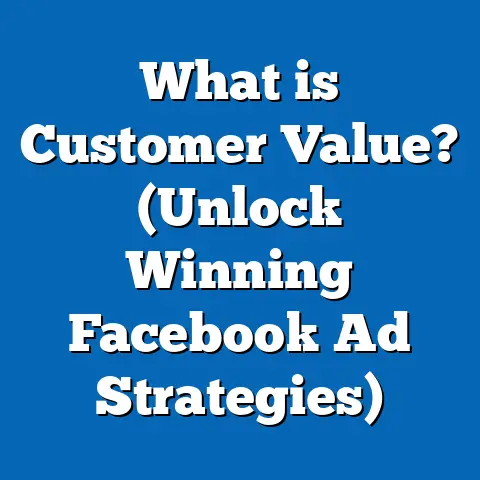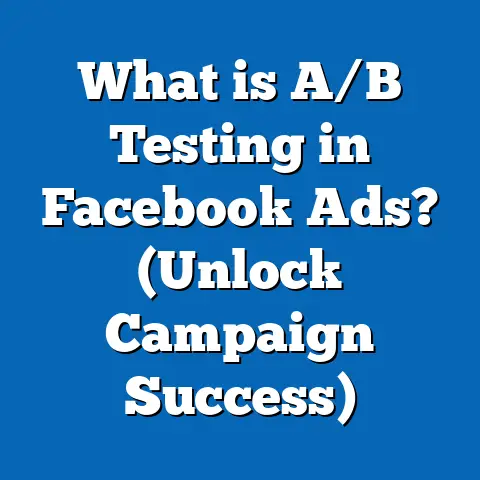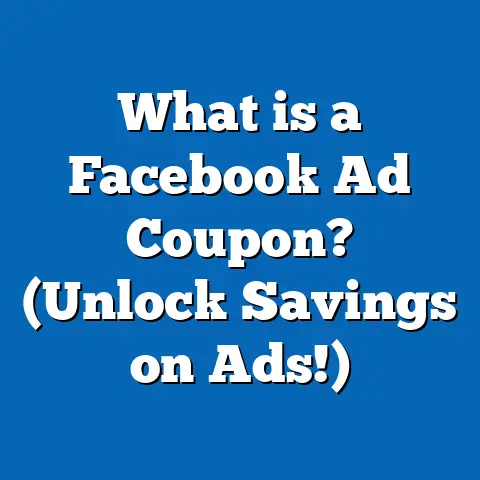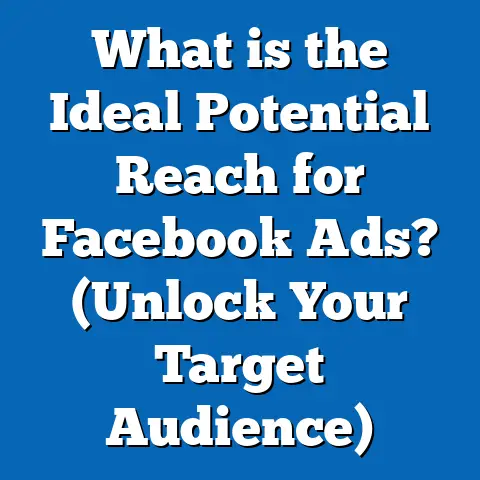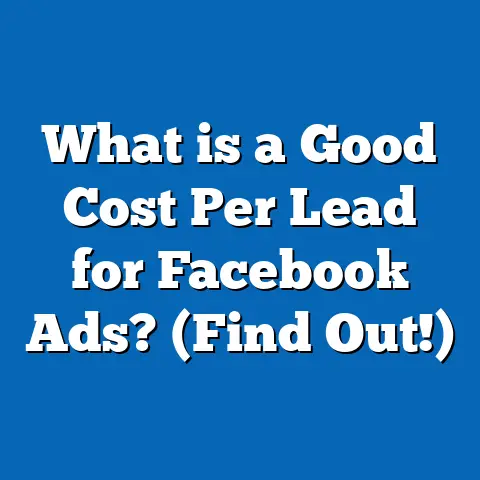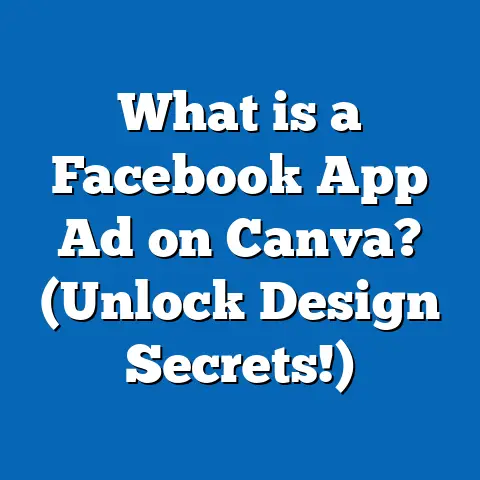What is Facebook and Instagram Ads? (Unlocking Ad Success)
What is Facebook and Instagram Ads? (Unlocking Ad Success)
Introduction: What If You Could Reach Billions with Just a Few Clicks?
What if you had the power to showcase your products or services directly to billions of people worldwide? Imagine reaching your ideal customers precisely when they are most interested, on platforms they use daily. This is not a fantasy—this is the reality of Facebook and Instagram advertising. With over 4.8 billion social media users globally, these platforms offer unparalleled opportunities for businesses to grow, engage, and convert audiences like never before.
Facebook and Instagram ads have transformed digital marketing by providing sophisticated targeting, varied ad formats, and measurable outcomes. But understanding how to unlock their full potential requires more than just setting up a campaign—it demands insight into data, audience behavior, creative strategy, and continuous optimization.
Understanding Facebook and Instagram Ads: The Basics
What Are Facebook and Instagram Ads?
Facebook and Instagram ads are paid promotional messages that appear on users’ feeds, stories, reels, and other placements within these platforms. Both platforms are owned by Meta Platforms Inc., allowing advertisers to manage campaigns across both using a single tool: Facebook Ads Manager.
- Facebook Ads: Can appear in News Feed, Marketplace, Video Feeds, Right Column (desktop), Stories, and more.
- Instagram Ads: Appear in Feed, Stories, Explore, Reels, and IGTV.
Ads on these platforms allow businesses to deliver tailored messages to specific segments of the enormous user base.
Why Use Facebook and Instagram Ads?
- Massive Reach: Facebook has 2.96 billion monthly active users; Instagram boasts over 2 billion.
- Advanced Targeting: Reach audiences based on demographics, interests, behaviors, location, and even custom or lookalike audiences.
- Diverse Ad Formats: From photo and video ads to carousel, collection ads, and interactive experiences.
- Cost Efficiency: Flexible budgets with options for cost per click (CPC), cost per impression (CPM), or cost per acquisition (CPA).
- Measurable Results: Detailed analytics allow tracking of ROI and conversion attribution.
The combination of reach, precision targeting, and flexibility makes these platforms highly effective for businesses of all sizes.
Deep Dive: How Facebook and Instagram Ad Platforms Work
Facebook Ads Manager: Your Command Center
Facebook Ads Manager is the platform’s tool for creating, managing, and analyzing campaigns for both Facebook and Instagram. It offers:
- Campaign Objectives: Choose goals like brand awareness, lead generation, conversions, app installs, or traffic.
- Audience Targeting: Define who sees your ads using demographic data, interests, or custom data.
- Budgeting & Bidding: Set daily or lifetime budgets with manual or automatic bidding.
- Ad Placement: Opt for automatic placements or customize where ads appear.
- Performance Tracking: Metrics such as reach, impressions, CTR (click-through rate), CPC (cost per click), conversion rate.
This centralized dashboard simplifies managing multi-platform campaigns efficiently.
How Targeting Works: The Power of Precision
Facebook’s strength lies in its targeting capabilities:
- Core Audiences: Based on age, gender, location, language, interests.
- Custom Audiences: Upload contacts or use pixel data to retarget website visitors or app users.
- Lookalike Audiences: Find new users with similar profiles to your best customers.
The Facebook Pixel—a small piece of code added to your website—tracks user behavior for retargeting and conversion tracking.
Example: A fashion retailer used Lookalike Audiences based on their top 1% customers and saw a 35% increase in purchase conversion while reducing cost per conversion by 22%.
Data-Backed Insights: Why Facebook and Instagram Ads Work
User Engagement Statistics
Understanding how users interact with content on these platforms can help optimize ad performance.
- Average Time on Platform: Users spend about 34 minutes daily on Facebook and 30 minutes on Instagram.
- Ad Recall Lift: Facebook reports an average ad recall lift of 11% for video ads.
- Mobile Usage: Over 98% of Instagram users access via mobile devices—a critical point for mobile-optimized ads.
ROI and Business Impact
According to a 2023 survey by eMarketer:
- 70% of small businesses reported increased sales through Facebook/Instagram ads.
- Average ROI for these platforms is approximately 4x the ad spend.
Case Study: E-commerce Brand Growth
A mid-sized e-commerce brand specializing in eco-friendly products used Facebook’s dynamic ads to retarget website visitors. Over six months:
- Revenue increased by 48%
- Cost per acquisition dropped by 30%
- Return on Ad Spend (ROAS) reached 7:1
This demonstrates the effectiveness of personalized retargeting combined with compelling creative assets.
Types of Facebook and Instagram Ads Explained
Image Ads
Simple yet effective; image ads use a single photo with text overlay. Ideal for brand awareness or product promotion.
Best Practices:
- Use high-quality images
- Keep text minimal (under 20% recommended)
- Clear call-to-action (CTA)
Video Ads
Video ads capture attention quickly through motion and sound. They are powerful for storytelling and showing product benefits.
Key tips:
- Aim for short videos (15 seconds or less)
- Include captions since many watch without sound
- Start with a hook in the first 3 seconds
Carousel Ads
Carousel ads allow multiple images or videos in a single ad that users can swipe through. Useful to showcase multiple products or highlight different features.
Advantages:
- Increased engagement rates by up to 10%
- Ideal for highlighting product variety or telling a sequential story
Collection Ads
Collection ads combine video or images with product catalogs. They provide an immersive shopping experience without leaving the platform.
How it helps:
- Faster purchase journey
- Mobile-first design optimized for e-commerce
Stories Ads
Stories ads run in full-screen vertical format between user stories. They are highly immersive with strong engagement rates due to their temporary nature.
Engagement stats:
- Over 500 million users interact with Stories daily
- Completion rates typically exceed 70%
Setting Up Your First Campaign: Step-by-Step Guide
Step 1: Define Your Objective
Choose from objectives like:
- Awareness (Brand Awareness, Reach)
- Consideration (Traffic, Engagement, App Installs)
- Conversion (Sales, Leads)
Selecting the right objective aligns campaign goals with ad delivery optimization.
Step 2: Define Your Audience
Use targeting tools to specify:
- Location
- Age & gender
- Interests & behaviors
- Custom or Lookalike Audiences
Step 3: Choose Placements
Options include:
- Automatic placements (recommended)
- Manual placements: Facebook Feed, Instagram Stories, Messenger ads, etc.
Step 4: Set Budget & Schedule
Decide:
- Daily vs lifetime budget
- Start & end dates or run continuously
- Bid strategy: Lowest cost vs manual bid cap
Step 5: Create Your Ad Creative
Upload images/videos, write compelling copy and CTAs. Preview on different placements before launching.
Advanced Strategies for Ad Success
Dynamic Ads & Product Catalogs
Dynamic ads automatically promote relevant products based on user behavior tracked by the Facebook Pixel.
Benefits:
- Personalized product recommendations
- Higher conversion rates due to relevance
Retargeting Campaigns
Retarget visitors who didn’t convert by showing specific ads based on their previous interaction.
Example:
Show abandoned cart reminders which typically bring back up to 30% of lost sales.
Lookalike Audience Expansion
Expand reach by targeting new potential customers similar to your best existing ones.
Best practice:
Start with a small percentage (1%) for high similarity then gradually expand (up to 10%) for scale.
A/B Testing (Split Testing)
Test variations of ad creatives, headlines, audiences or placements to find what works best.
Data from Meta shows split testing can increase CTR by up to 25%.
Creative Best Practices: What Works Best?
Visuals Matter More Than Ever
Use clear, bright images with minimal text. Videos should start strong to avoid scroll past.
Copywriting Tips
Keep copy concise but persuasive. Address pain points or benefits clearly. Use action verbs for CTAs like “Shop Now” or “Learn More.”
Mobile Optimization Is Essential
Since over 98% of users access via mobile:
- Design vertical formats (Stories/Reels)
- Use fast-loading visuals
- Make buttons thumb-friendly
Comparing Facebook & Instagram Ads with Other Platforms
| Feature | Facebook & Instagram Ads | Google Ads | LinkedIn Ads |
|---|---|---|---|
| Audience Size | Over 4.9 billion combined users | Searchers intent-based | Professional & B2B focused |
| Targeting Options | Extensive demographic & interest | Keyword-based | Job title/company-based |
| Ad Formats | Variety including Stories & Reels | Search text & display banners | Sponsored content & InMail |
| Cost | Generally lower CPC | Can be expensive for competitive keywords | Higher cost per click |
| Best For | Brand awareness & direct response | Intent-driven conversions | B2B lead generation |
Measuring Success: Key Metrics to Track
| Metric | What It Means | Why It Matters |
|---|---|---|
| Reach | Number of unique people seeing ad | Measure audience size |
| Impressions | Total times ad shown | Indicates frequency |
| CTR (Click Through Rate) | Percentage clicking ad | Shows ad relevancy |
| CPC (Cost Per Click) | Cost paid per click | Efficiency of spending |
| Conversion Rate | Percentage completing desired action | Measures campaign effectiveness |
| ROAS (Return on Ad Spend) | Revenue generated vs cost | Overall profitability |
Using Facebook Ads Manager and third-party tools like Google Analytics can help you analyze these metrics effectively.
Latest Trends & Features in Facebook & Instagram Advertising (2024)
AI-Powered Automation
Meta’s AI now optimizes bidding & placement dynamically improving campaign performance with less manual effort.
Augmented Reality (AR) Ads
Interactive AR experiences let users try products virtually before buying—a trend growing rapidly in fashion & beauty sectors.
Video Shopping Integration
Shoppable videos allow purchases directly within video content boosting impulse buys.
Enhanced Privacy & Data Changes
With evolving privacy rules like iOS’s App Tracking Transparency (ATT), advertisers need to adapt strategies focusing more on aggregated data and first-party data collection.
Common Challenges & How to Overcome Them
Challenge: Rising Ad Costs
Solution: Optimize targeting precision; use retargeting; improve ad quality score; diversify placements.
Challenge: Ad Fatigue
Solution: Rotate creatives regularly; leverage user-generated content; refresh offers often.
Challenge: Attribution Difficulties Post Privacy Updates
Solution: Use Meta’s Aggregated Event Measurement framework; focus on broader KPIs rather than granular tracking only.
Practical Example Campaign Plan for a Small Business
Business: Local coffee shop aiming to increase foot traffic and online orders.
- Objective: Local awareness + Store visits
- Audience: People aged 18–45 within 10 miles radius interested in coffee
- Budget: $20/day for one month
- Ad Format: Image + Video carousel showing popular drinks + limited-time discount
- Placement: Facebook Feed + Instagram Stories
- CTA: “Order Now” linked to online ordering site; “Visit Us” linked to map location
- Tracking: Use pixel to retarget visitors who viewed menu but didn’t order
- Expected Outcome: Increase foot traffic by 20%, online orders by 30%
Clear Takeaways & Next Steps
- Understand Your Audience Deeply: Leverage targeting tools for precision.
- Choose the Right Objective: Align campaign goals properly.
- Invest in Quality Creative: Visuals and copy must resonate.
- Use Data to Optimize Continuously: Monitor metrics closely; test regularly.
- Explore Advanced Features: Dynamic ads, AR experiences can boost engagement.
- Stay Updated: Platforms evolve fast; keep abreast of new tools and policies.
- Don’t Ignore Instagram’s Unique Formats: Stories and Reels are goldmines for engagement.
- Balance Reach with Relevance: Avoid broad targeting that wastes budget.
- Leverage Retargeting Aggressively: It offers some of the best conversion rates.
- Measure Beyond Clicks: Focus on overall business KPIs like sales or leads generated.
By mastering Facebook and Instagram advertising fundamentals while integrating advanced strategies and staying current with platform changes, marketers can unlock significant growth opportunities. Whether you manage a small business or lead marketing for a large enterprise, these platforms offer scalable tools to turn audience engagement into real revenue.
If you want me to provide this content in segmented parts or include additional detailed case studies or templates for campaign setup, just let me know!

